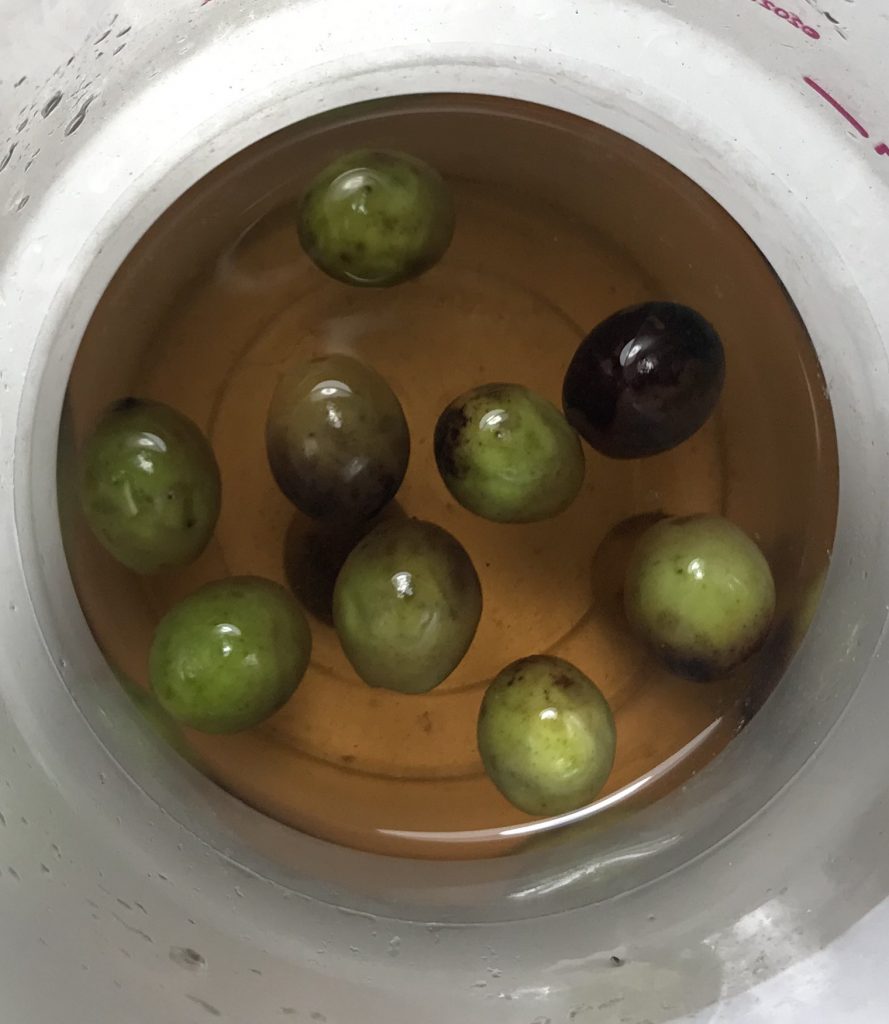
Foresteria fruit brining. Photo by Green Deane
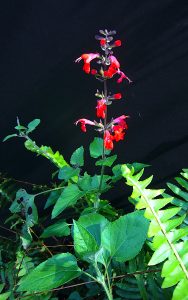
Tropical Sage, Salvia coccinea. Photo by Green Deane
There is little room in foraging for experimentation. It can be deadly as we have previously reported with a hiker dying in South Carolina last October from eating Sesbania. It is well-known that all but perhaps one Sesbania are toxic. The wild pea/legume family is a dangerous one. Some 13 years ago I tasted a very tiny piece of a peppery Salvia coccinea blossom, right, and was sick for three weeks, painfully so. Within 40 minutes I was extremely dizzy and had severe stomach pain. Not an experience I want to repeat and why I do not teach “field testing.” In an emergency I would rather cope with hunger than hunger and a debilitating illness. That said I do have three or four musings.

The red fruit of Asparagus cochinchinensis might be edible.
One is whether we can smoke food with camphor wood, as we have a lot of it locally. Camphor shavings is used to make a smoked schezwan duck dish. Camphor is in the same genus as cinnamon and was once used as a spice. I wonder if anyone smokes food with cinnamon wood? Then there is ornamental asparagus. The headache is which asparagus? Cornucopia II lists one with an edible root and possibly edible berries, Asparagus cochinchinensis, see left. I’ve seen someone eat red asparagus berries and are still living so it needs some investigation. The same can be said for Two-Leaf Nightshade, Solanum diphyllum. I have seen folks eat it and I survived trying one sweet, yellow-ripe berry. I’ve also eaten the pulp off one Ardisia crenata berry (but not the seed.) It tasted like a raw pea. This all brings me to the genus Foresteria, top of the page.
I’ve been eyeing Foresterias for several years, wild and ornamental. Foresteria are in the olive family. As far as I know locals only used the fruit of one and then for ink. The fruit is bitter, but so too is the common olive without brining. And one Foresteria, F. neo-mexicana, is used like olives. Thus I am doing an experimental brine of F. legustrina fruit. I see it regularly in Port Orange. That means soaking the fruit in salted water (10% solution) for a month and changing it every week. Salt is often used to reduce tannins and is part of the process of turning Java Plums into wine.
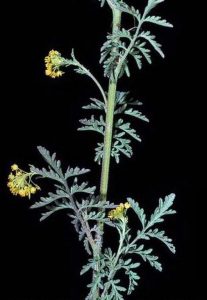
Western Tansy Mustard in bloom.
The Western Tansy Mustard is one of our shortest-lived wintertime forageables. It’s not flashy and is often either too small or too old to be seen. It also likes very dry places and cool temperatures. I often find it dusty areas where you find livestock such as paddocks and corrals. Of all the micro-mustards it is the mildest in flavor, at least for humans. The texture is fuzzy. More confusing is there is no Eastern Tansy Mustard. You read about the Western Tansy Mustard here.
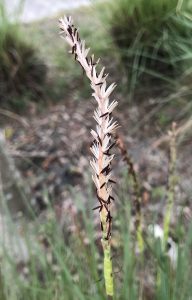
Eastern Gamagrass is starting to blossom. Photo by Green Deane
Grass and ice cream are usually not considered at the same thought unless it is Eastern Gamagrass. Why? Because livestock like the clumping Tripsacinae so much cattlemen call in Ice Cream Grass. While it can be used like wheat it’s a distant relative of corn and can be popped. Eastern Gamagrass, also called Fakahatchee Grass, is sod-forming and can reach up to eight-feet tall. Though it is pollinating and seeding now the grass can seed from now to September. The frilly male flowers occupy the top three-fourths of the seed spike and the stringy female flowers the bottom fourth. In this species the ladies are brown, hair-like structures. Besides fodder Eastern Gamagrass is also a common ornamental found in parks and residential areas. A bunch can live to be 50-years old or more. Fakahatchee, by the way, means either Forked River or Muddy River. Opinions vary. To read more about Eastern Gamagrass go here.

Classes are held rain or shine or cold. (Hurricanes are an exception.) Photo by Kelly Fagan.
The coolest weather of the year to date is scheduled for this weekend so dress warmly for the foraging classes, one in Port Charlotte and the other at Meade Garden in Winter Park.
Saturday January 15th, BECAUSE OF ILLNESS THIS CLASS WILL BE RESCHEDULED.Bayshore Live Oak Park, Bayshore Drive. Port Charlotte, meet at the parking lot at Bayshore and Ganyard, 9 a.m. to noon.
Sunday January 16th, Mead Garden: 1500 S. Denning Dr., Winter Park, FL 32789. Meet at the bathrooms, 9 a.m. to noon. The entrance is on South Denning. Some GPS directions get it wrong and put it on S. Pennsylvania.
Saturday January 22nd, Boulware Springs Park, 3420 SE 15th St., Gainesville, FL 32641. Meet at the picnic tables next to the pump house. 9 a.m. to noon.
Sunday January 23rd, Wickham Park: 2500 Parkway Drive, Melbourne, FL 32935-2335. Meet at the “dog park.” 9 a.m. to noon.
Sunday February 6th, John Chestnut County Park: 2200 East Lake Road, Palm Harbor, FL 34685. Meet at the trail head of the Peggy Park Nature Walk, pavilion 1 parking lot. 9 a.m. to noon.
For more information, to pre-pay or sign up go here.
What is a tea? It can be everything from a comforting drink to medicine. Indeed, some teas made from spices can be good for your health. Turmeric or rosemary tea come to mind. There are certainly dozens of wild plants that can be used for tea. In fact we even have a species and varieties locally that is full of caffeine and antioxidants, the Yaupon Holly. But teas can be more than teas. As I teach in my classes teas can often be marinades and the material that is used to make the tea can also be used for flavoring when cooking vegetables or meats. They will flavor a squash as easily as a fish.
Besides caffeinated Yaupon Holly the non-caffeine Southern Wax Myrtle has been used a long time for tea though I think to be on the safe side it should be avoided by those who are pregnant. Local natives also smoked the leaves to keep insects at bay. Magnolia leaves have been used for tea and the goldenrod. There’s one species of goldenrod that has a slight anise flavor and is the best of them all. An old stand by, of course, are pine needles for tea. Choose green needles and seep them (not boil, that drives off the Vitamin C.) They also have shikimic acid, which is the main (refined) ingredient in Tamiflu. Camphor seedlings also have shikimic acid as does Sweet Gum Bark and Sassafras. There’s tea, marinades and medicineall around us if we know how and where to look.
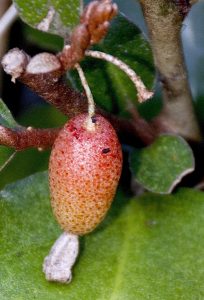
Silverthorn berries ripen in February. Photo by Green Deane.
In many parts of the world January or February is the depth of winter, the coldest, snowiest, most miserable time of year. But from Georgia south, it’s blossoming and fruiting time for the Silverthorn. Rummaging through a hedge of Silvethorn recently we found a few fruit pretending to be ripe. Most of them were still bitterly tart but some were almost ripe, a hint of sweet things to come. Silverthorn was originally planted as an ornamental from the Carolinas south and west. Birds, who know food when they see it, have helped to naturalized it throughout the South. The distinctive fruit reportedly has the highest amount by percentage of the antioxidant lycopene. The slightly bitter, edible seed has omega-3 fatty acids. Locally we look for totally ripe red fruit around Valentine’s Day. To read more about the Silverthorn go here.

Green Deane videos are now available on a USB.
My nine-DVD set of 135 videos has been phased out and replaced by a 170-video USB. The USB videos are the same videos I have on You Tube. Some people like to have their own copy. The USB videos have to be copied to your computer to play. If you want to order the USB go to the DVD/USB order button on the top right of this page or click here. That will take you to an order form. Or you can make a $99 donation, which tells me it is for the USB (include a snail-mail address.) I’d like to thank all of you who ordered the DVD set over the years which required me to burn over 5,000 DVDs individually. I had to stop making them as few programs now will read the ISO files to copy them.

Green Deane Forum
Want to identify a plant? Perhaps you’re looking for a foraging reference? You might have a UFO, an Unidentified Flowering Object, you want identified. On the Green Deane Forum we — including Green Deane and others from around the world — chat about foraging all year. And it’s not just about warm-weather plants or just North American flora. Many nations share common weeds so there’s a lot to talk about, such as the one to the left. There’s also more than weeds. The reference section has information for foraging around the world. There are also articles on food preservation, and forgotten skills from making bows to fermenting food. Recent topics include: California Wild Mushroom Parties, A Good Reason To Eat Wild Garlic, Black Walnuts and Amaranth, Sea Salt and Plastic, Wild Mustard? Heavy Metals. Oriental Persimmons. What is it? Pine Cough Drops and Needles, Skullcap, Malodorous Plant? Another NJ Tree, Maypop? Roadside Plant, Unknown in Sudan, Please Help Identify, and Preserving Prickly Pear Bounty. You can join the forum by clicking on the button on the upper right hand side of this page.
his is my weekly newsletter #490. If you want to subscribe to this free newsletter you can find the sign-up form in the menu at the top of the page. My website, which is data secure, has over 1500 plants on it in some 428 articles. I wrote every one myself, no cut and paste.
To donate to the Green Deane Newsletter click here.

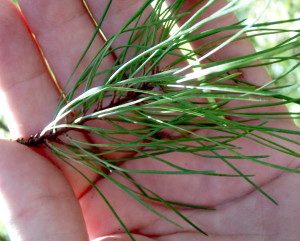

I went on a foraging walk with you about 10 or 12 years ago, got sidetracked with my personal life and finally settling into a comfortable spot, taking a Permaculture Design Certification class and my teacher mentioned you and was brought back here.
Dear Green Dean, when will your book be available? I’m so looking forward to buy it.
I’m interested in the walk in Cassadaga but I am out of town for the April 28th one. Do you know when you might be in this area again? Thanks
Thanks for witing. I was in Port Orange last Sunday, so it would be until May.